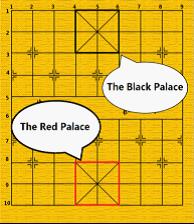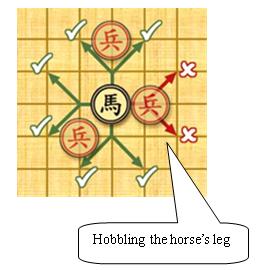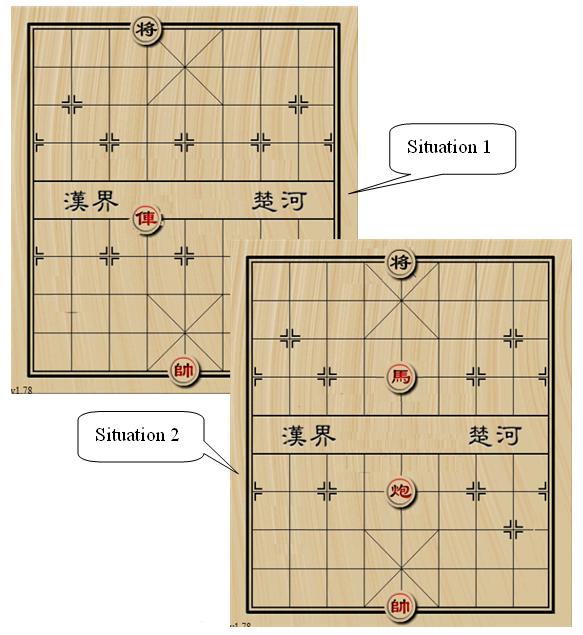Xiangqi is one of the most popular two-player board games in China. The game represents a battle between two armies with the goal of capturing the enemy's ``general" piece. In this problem, you are given a situation of later stage in the game. Besides, the red side has already ``delivered a check". Your work is to check whether the situation is ``checkmate".
Now we introduce some basic rules of Xiangqi. Xiangqi is played on a 10 x 9 board and the pieces are placed on the intersections (points). The top left point is (1,1) and the bottom right point is (10,9). There are two groups of pieces marked by black or red Chinese characters, belonging to the two players separately. During the game, each player in turn moves one piece from the point it occupies to another point. No two pieces can occupy the same point at the same time. A piece can be moved onto a point occupied by an enemy piece, in which case the enemy piece is``captured" and removed from the board. When the general is in danger of being captured by the enemy player on the enemy player's next move, the enemy player is said to have ``delivered a check". If the general's player can make no move to prevent the general's capture by next enemy move, the situation is called ``checkmate".

We only use 4 kinds of pieces introducing as follows:

Now you are given a situation only containing a black general, a red general and several red chariots, cannons and horses, and the red side has delivered a check. Now it turns to black side's move. Your job is to determine that whether this situation is ``checkmate".
The input contains no more than 40 test cases. For each test case, the first line contains three integers representing the number of red pieces N ( 2![]() N
N![]() 7) and the position of the black general. The following N lines contain details of N red pieces. For each line, there are a char and two integers representing the type and position of the piece (type char `G' for general, `R' for chariot, `H' for horse and `C' for cannon). We guarantee that the situation is legal and the red side has delivered the check.
7) and the position of the black general. The following N lines contain details of N red pieces. For each line, there are a char and two integers representing the type and position of the piece (type char `G' for general, `R' for chariot, `H' for horse and `C' for cannon). We guarantee that the situation is legal and the red side has delivered the check.
There is a blank line between two test cases. The input ends by `0 0 0'.
For each test case, if the situation is checkmate, output a single word ` YES', otherwise output the word ` NO'.
Hint: In the first situation, the black general is checked by chariot and ``flying general''. In the second situation, the black general can move to (1, 4) or (1, 6) to stop check. See the figure below.

2 1 4 G 10 5 R 6 4 3 1 5 H 4 5 G 10 5 C 7 5 0 0 0
YES NO
看到這麼個問題確實有點頭疼,但是仔細想過之後不難用模擬來解決問題,附上代碼(略長);
1 #include<stdio.h>
2 #include<string.h>
3 struct L
4 {
5 int a,b;
6 };
7 struct L General;
8 struct L Chariot[2];
9 struct L Horse[2];
10 struct L Cannon[2];
11 int Qipan[11][10];
12 int n,x,y;
13 int tempx,tempy;
14 char type[10];
15 int i1,i2,i3;
16 int mainflag;
17 int checkGenerals(int,int);
18 int checkChariot(int,int,int,int);
19 int checkHorse(int,int,int,int);
20 int checkCannon(int,int,int,int);
21 int checkPoint(int,int);
22 int main()
23 {
24 while(scanf("%d%d%d",&n,&x,&y)==3&&n)
25 //Pay attention to the point (x,y),which is the black general located.
26 {
27 memset(Qipan,0,sizeof(Qipan));
28 //Create a Qipan and define all of it are 0.
29 Qipan[x][y]=1;
30 // When put some point on the broad,transfer it into 1.
31 //input the date,and store it into struct General,Chariot,Horse,Cannon.
32 i1=i2=i3=0;
33 for(int i=0;i<n;i++)
34 {
35 scanf("%s%d%d",type,&tempx,&tempy);
36 Qipan[tempx][tempy]=1;
37 if(type[0]=='G')
38 {
39 General.a=tempx;
40 General.b=tempy;
41 }
42 else if(type[0]=='R')
43 {
44 Chariot[i1].a=tempx;
45 Chariot[i1++].b=tempy;
46 }
47 else if(type[0]=='H')
48 {
49 Horse[i2].a=tempx;
50 Horse[i2++].b=tempy;
51 }
52 else if(type[0]=='C')
53 {
54 Cannon[i3].a=tempx;
55 Cannon[i3++].b=tempy;
56 }
57 }
58 // Now it's high time to deal with the problem,with all of the dates are stored in order.
59 // The first we must check whether the two generals face to face directly.
60 if(checkGenerals(x,y))
61 {
62 printf("NO\n");
63 continue;
64 }
65 mainflag=0;
66 if(x+1<4)
67 {
68 Qipan[x][y]=0;
69 Qipan[x+1][y]++;
70 if(checkPoint(x+1,y))
71 mainflag=1;
72 Qipan[x][y]=1;
73 Qipan[x+1][y]--;
74 }
75 if(mainflag)
76 {
77 printf("NO\n");
78 continue;
79 }
80 if(x-1>0)
81 {
82 Qipan[x][y]=0;
83 Qipan[x-1][y]++;
84 if(checkPoint(x-1,y))
85 mainflag=1;
86 Qipan[x][y]=0;
87 Qipan[x-1][y]--;
88 }
89 if(mainflag)
90 {
91 printf("NO\n");
92 continue;
93 }
94 if(y+1<7)
95 {
96 Qipan[x][y]=0;
97 Qipan[x][y+1]++;
98 if(checkPoint(x,y+1))
99 mainflag=1;
100 Qipan[x][y]=0;
101 Qipan[x][y+1]--;
102 }
103 if(mainflag)
104 {
105 printf("NO\n");
106 continue;
107 }
108 if(y-1>3)
109 {
110 Qipan[x][y]=0;
111 Qipan[x][y-1]++;
112 if(checkPoint(x,y-1))
113 mainflag=1;
114 Qipan[x][y]=1;
115 Qipan[x][y-1]++;
116 }
117 if(mainflag)
118 {
119 printf("NO\n");
120 continue;
121 }
122 printf("YES\n");
123 }
124 }
125 int checkGenerals(int x,int y)
126 {
127 if(General.b==y)
128 {
129 int Flag=0;
130 for(int i=x+1;i<General.a;i++)
131 if(Qipan[i][y])
132 Flag++;
133 if(Flag==0)
134 return 1;
135 }
136 return 0;
137 }
138 int checkChariot(int x1,int y1,int x2,int y2)
139 {
140 int Flag;
141 int xj1,yj1,xj2,yj2;
142 xj1=x1<x2?x1:x2;
143 xj2=x1>x2?x1:x2;
144 yj1=y1<y2?y1:y2;
145 yj2=y1>y2?y1:y2;
146 if(x1==x2&&y1==y2)
147 return 0;
148 if(x1==x2)
149 {
150 Flag=0;
151 for(int j=yj1+1;j<yj2;j++)
152 if(Qipan[x1][j])
153 Flag=1;
154 if(Flag==0) return 1;
155 }
156 if(y1==y2)
157 {
158 Flag=0;
159 for(int i=xj1+1;i<xj2;i++)
160 if(Qipan[i][y1])
161 Flag=1;
162 if(Flag==0) return 1;
163 }
164 return 0;
165 }
166 int checkHorse(int x1,int y1,int x2,int y2)
167 {
168 if(x1+1==x2&&y1+2==y2)
169 if(Qipan[x1][y1+1]==0)
170 return 1;
171 if(x1+1==x2&&y1-2==y2)
172 if(Qipan[x1][y1-1]==0)
173 return 1;
174 if(x1-1==x2&&y1+2==y2)
175 if(Qipan[x1][y1+1]==0)
176 return 1;
177 if(x1-1==x2&&y1-2==y2)
178 if(Qipan[x1][y1-1]==0)
179 return 1;
180 if(x1+2==x2&&y1+1==y2)
181 if(Qipan[x1+1][y1]==0)
182 return 1;
183 if(x1+2==x2&&y1-1==y2)
184 if(Qipan[x1+1][y1]==0)
185 return 1;
186 if(x1-2==x2&&y1+1==y2)
187 if(Qipan[x1-1][y1]==0)
188 return 1;
189 if(x1-2==x2&&y1-1==y2)
190 if(Qipan[x1-1][y1]==0)
191 return 1;
192 return 0;
193 }
194 int checkCannon(int x1,int y1,int x2,int y2)
195 {
196 int Flag=0;
197 int xj1,yj1,xj2,yj2;
198 xj1=x1<x2?x1:x2;
199 xj2=x1>x2?x1:x2;
200 yj1=y1<y2?y1:y2;
201 yj2=y1>y2?y1:y2;
202 if(x1==x2&&y1==y2) return 0;
203 if(x1==x2)
204 {
205 for(int j=yj1+1;j<yj2;j++)
206 if(Qipan[x1][j]) Flag++;
207 if(Flag==1) return 1;
208 }
209 if(y1==y2)
210 {
211 for(int i=xj1+1;i<xj2;i++)
212 if(Qipan[i][y1]) Flag++;
213 if(Flag==1) return 1;
214 }
215 return 0;
216 }
217 int checkPoint(int x,int y)
218 {
219 if(checkGenerals(x,y))
220 return 0;
221 for(int i=0;i<i1;i++)
222 if(checkChariot(Chariot[i].a,Chariot[i].b,x,y))
223 return 0;
224 for(int i=0;i<i2;i++)
225 if(checkHorse(Horse[i].a,Horse[i].b,x,y))
226 return 0;
227 for(int i=0;i<i3;i++)
228 {
229 if(checkCannon(Cannon[i].a,Cannon[i].b,x,y))
230 return 0;
231 }
232 return 1;
233 }